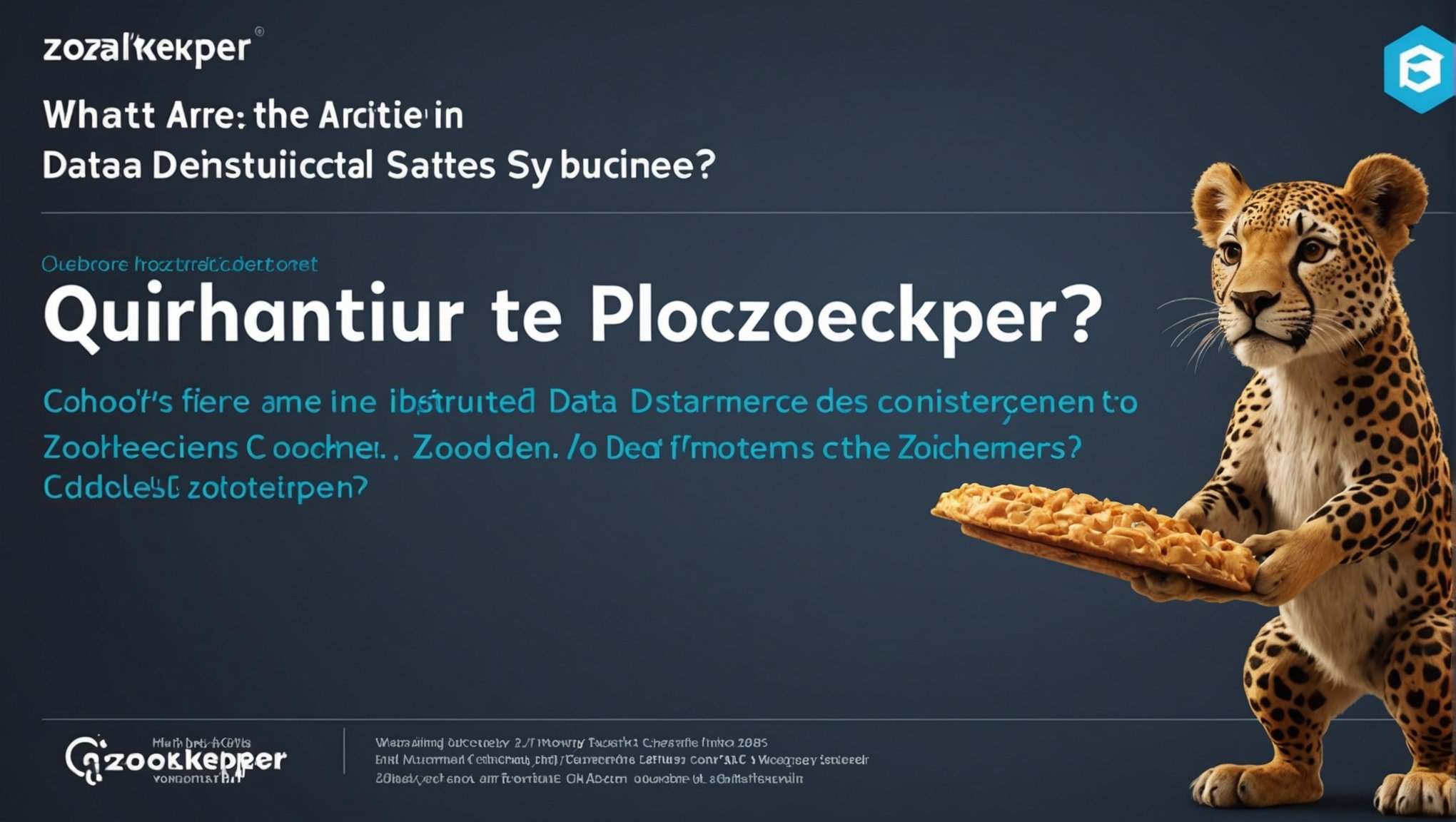Data consistency in distributed systems is a central concern for developers and network architects alike. The challenge of maintaining a consistent state across multiple nodes in a cluster is significant, but Apache Zookeeper provides a robust solution. This article delves into the methods of ensuring data consistency in distributed systems using Apache Zookeeper. We will explore the key features and functionalities of Zookeeper, how it maintains data consistency, and why it is crucial for modern distributed applications.
Understanding Apache Zookeeper and Its Role in Distributed Systems
Apache Zookeeper is an open-source service designed to coordinate and manage large sets of distributed applications. It provides the essential building blocks that allow distributed applications to work with a high level of data consistency while handling the complexity of distributed systems.
Also to discover : How do you set up Apache Airflow for scheduling and orchestrating data workflows?
Zookeeper acts as a centralized service for maintaining configuration information, naming, providing distributed synchronization, and managing group services. At its core, Zookeeper offers a simple interface to a hierarchical namespace referred to as znodes, which are analogous to files and directories in a file system. This namespace is crucial for managing distributed database systems and other distributed applications because it ensures that the data is consistently available across multiple nodes.
The Basics of Zookeeper Servers and Znodes
A Zookeeper ensemble consists of a collection of Zookeeper servers. These servers run in a cluster and provide high availability by replicating data across all nodes. Each server in the ensemble is responsible for maintaining a synchronized copy of the znodes. When a client connects to a Zookeeper server, it will interact with this hierarchical namespace, creating or updating znodes as needed.
Also to read : How can you use AWS Step Functions to manage complex workflows in a serverless architecture?
Znodes can be persistent or ephemeral. Persistent znodes remain in the namespace until explicitly deleted, while ephemeral znodes exist only as long as the session that created them is active. This ephemeral nature is particularly useful for maintaining transient states, such as leader election in a distributed system.
The Importance of Leader Election and High Availability
One of the pivotal roles of Zookeeper is leader election. In a distributed system, some tasks must be performed by a single node, the leader, to avoid conflicts and ensure data consistency. Zookeeper uses a leader election algorithm to designate one node as the leader, with the others acting as followers. This process guarantees that there is always one node responsible for critical updates and coordination tasks.
Leader Election Process
The leader election process in Zookeeper involves all nodes participating in an election to decide which node will become the leader. The election process uses ephemeral znodes to track the state of each participating node. When a node creates an ephemeral znode, it signals its candidacy for leadership. If the node loses its connection to the Zookeeper server, its znode is automatically deleted, and a new election is triggered.
This mechanism ensures that there is always a single leader managing the critical operations, thereby maintaining strong consistency in the distributed system. The followers continuously monitor the leader’s status and are ready to take over if the leader node fails, providing high availability and ensuring the system’s stability.
Ensuring Data Consistency with Zookeeper
Zookeeper plays a crucial role in ensuring data consistency across distributed systems. One of its core features is the Atomic Broadcast Protocol (Zab), which guarantees that updates are applied consistently across all Zookeeper servers. This protocol is fundamental in maintaining a consistent state within the cluster.
Strong Consistency vs. Eventual Consistency
In distributed systems, consistency models can vary. Strong consistency ensures that any read operation always returns the most recent write, while eventual consistency allows for some lag before all nodes reflect the latest update. Zookeeper’s emphasis on strong consistency makes it ideal for applications where timely accuracy is paramount.
When a client requests to update a znode, the Zookeeper server receiving the request acts as the coordinator. It forwards the request to the leader, which then proposes the update to all follower nodes. The update is only applied once a majority of the nodes (quorum) acknowledge it, ensuring that all nodes will eventually reflect the same state. This process ensures both data consistency and fault tolerance, as it can accommodate server failures without compromising the system’s integrity.
Maintaining Data Consistency in a Zookeeper Cluster
The architecture of a Zookeeper cluster is designed to ensure consistency distributed across all nodes. Each node maintains a full copy of the data tree, ensuring that they are synchronized through the Zab protocol. This redundancy is critical for maintaining high availability and ensuring data consistency even in the face of individual server failures.
Additionally, Zookeeper’s write-ahead logging mechanism ensures that any updates are durably stored before being applied. This approach provides an extra layer of reliability, as it allows the system to recover to a consistent state even after unexpected crashes.
Using Zookeeper for Distributed Applications and Systems
Zookeeper’s versatility makes it a valuable tool for a wide range of distributed applications. From managing distributed databases to coordinating microservices, Zookeeper’s robust consistency mechanisms prove indispensable.
Configuration Management and Service Discovery
One of the essential uses of Zookeeper in distributed applications is configuration management. By storing configuration data in znodes, Zookeeper ensures that all nodes in the system have access to the latest configurations. This centralized management simplifies the deployment and scaling of distributed systems.
Service discovery is another critical application. In a microservices architecture, services need to find and communicate with each other reliably. By using Zookeeper, services can register themselves and discover other services dynamically, ensuring seamless integration and coordination.
Real-World Applications
Many high-profile organizations leverage Zookeeper for its data consistency and coordination capabilities. For instance, Hadoop relies on Zookeeper for cluster management, while Apache Kafka uses it for managing distributed message brokers. These real-world applications underscore the importance of Zookeeper in building resilient, scalable, and consistent distributed systems.
Practical Considerations and Best Practices
While Zookeeper offers a powerful framework for ensuring data consistency in distributed systems, it’s essential to follow best practices to maximize its effectiveness.
Deployment and Configuration
Deploying a Zookeeper ensemble requires careful planning. A typical setup involves an odd number of servers to form a quorum, which is crucial for maintaining high availability. Each server should be deployed on separate physical or virtual machines to avoid single points of failure.
When configuring Zookeeper, it’s essential to optimize the server settings, such as session timeouts, to balance performance and reliability. Regular monitoring and maintenance are also crucial to ensure the system’s health and responsiveness.
Handling Client Connections
Clients typically connect to Zookeeper servers using the “localhost connected” approach for development and testing. In production, clients should use a list of Zookeeper servers to distribute the load and provide failover capabilities. By following these practices, you ensure that your applications can maintain consistent and reliable connections to the Zookeeper ensemble.
Monitoring and Maintenance
Ongoing monitoring is critical for maintaining the health of a Zookeeper ensemble. Tools like the Zookeeper AdminServer can provide valuable insights into the system’s status, helping you proactively address issues. Regular backups and log management are also essential practices to ensure that data is not lost and the system can recover quickly from failures.
In conclusion, Apache Zookeeper is an indispensable tool for ensuring data consistency in distributed systems. Its robust architecture, featuring leader election, strong consistency through the Zab protocol, and comprehensive configuration management, makes it ideal for a wide range of distributed applications. By leveraging Zookeeper, you can achieve high availability, ensure data consistency, and manage the complexity of distributed systems effectively.
By implementing the methods and best practices outlined in this article, you can harness the full potential of Apache Zookeeper to build and maintain resilient, consistent, and scalable distributed systems. Whether you’re managing a distributed database, coordinating microservices, or handling complex configurations, Apache Zookeeper provides the tools you need to succeed.











